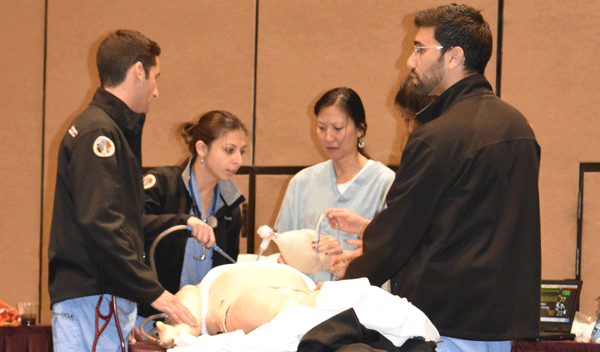The goal for simulation is not task completion but optimization.
Medical simulation was first formalized with roots in military medicine as a modality to practice in a low-risk or risk-free environment.1 Since its inception, it has found its way into graduate medical education across all specialties, with varying styles of clinical presentation and learner exposure – from basic task trainers to fully immersive high-fidelity environments using interactive computer-based simulators (aka Sim Man).2 Each type of simulation is designed to help develop a different skill in its participants. Task trainers, such as those used for specialized procedures (eg, central lines, intubation, thoracotomy), can provide targeted training with specific teaching goals in a safe and protected teaching environment.3
Recent medical literature reveals that residents exposed to medical simulation training gain academic confidence, decision-making skills, multi-tasking abilities, teamwork, and standardized testing skills (eg, oral boards).4 Emergency medicine (EM) programs are also turning increasingly to simulation to aid residents in preparing for a series of medical situations, from common case presentations such as acute myocardial infarction to high risk-low incidence situations, such as perimortem cesarean section. Currently, 91% of EM residencies utilize some form of simulation for education with their residents.5
To help new residents navigate the expansive ocean of medical simulation, authors from various academic institutions created a list of tips, revised and reviewed based on available simulation literature (see page 37).
Next Steps
Now that you're excited about it, run with it! Encourage your residency program to try more simulation in the place of traditional lecture-based didactics, or simply schedule some time in the simulation lab to work on a skill or patient case. Consider joining the EMRA Simulation Division or competing in the EMRA SIMWars competition at ACEP17. Options exist for how to engage in simulation as a resident, and it's up to you to make it your own!
Top 5 Tips to Get the Most Out of Simulation in Residency
These 5 pointers will ease new residents into simulation and maximize the potential benefits.
1. Pre-Reading
Have an idea of what broad categories or topics may come up during your simulation experience (eg, pediatrics, toxicology, etc.). Try to preview some relevant material prior to your active learning session in order to minimize the knowledge gap. This will allow you to focus better on identifying issues and learning systematic approaches during the session. Studying material ahead of time also empowers the learner to ask more informed questions or to target a particular area of weakness.
2, Have a Plan of Attack (Systematic, Roles)
In any real clinical case in the acute care setting, there is a systematic approach to the patient. As medical students, most learn how to perform a full history and physical in a logical format. As residents, these methods of become increasingly important because there now exists a management component. When beginning a simulation case, consider assigning roles. Decide who will be the team leader, who will do procedures, etc. This is very much akin to the roles that exist in real codes or shock/trauma shifts. Once each team member has an assigned task, consider the best way to gather information, assess, and manage the patient. This involves not only having a prioritized and comprehensive method to approach the patient, but also employing a closed-loop communication model that minimizes medical errors and patient safety concerns.
3. Start with the End in Mind (Have Clear Goals, Objectives)
As with any part of medical education, have a clear idea of what you want to accomplish during the training session. For some, this may be a chance to learn how to identify particular pathologies, while for others it may be a chance to practice the Focused Assessment with Sonography in Trauma (FAST) ultrasound exam in a controlled environment. It may be helpful to let the simulation session leaders know what your objectives for the session are so they can help you better achieve them.
4. Work on the Process, NOT the Result
We often catch ourselves doing things out of habit or out of past experience without knowing why we do them. When running a simulation case, continuously work to improve and examine the process used to achieve the desired end result. Knowing the how and why enables you to achieve a greater level of understanding and perfect the systems process. There is a lot to be learned in how to approach an issue in multiple fashions and why each of those options exists. Plus, having a process allows you to think clearly in challenging cases.
5. Reflect/Get Feedback
Ultimately, simulation is a chance to try and refine techniques without risk to patients. Instead of achieving a task, one can re-run a scenario multiple times to find the way that works best. The goal for simulation is not task completion but optimization. This is why it important to reflect on each session and gather feedback about what went well and what could be improved upon. Remember that when interacting with a real patient, everything is done to ensure the best possible outcome. Simulation allows the opportunity, through trial and error, to create the most efficient method for achieving the best outcome.
References
- Lateef F. Simulation-based learning: Just like the real thing. J Emerg Trauma Shock. 2010;3(4):348-352.
- Ojha R, Liu A, Rai D, Nanan R. Review of Simulation in Pediatrics: The Evolution of a Revolution. Front Pediatr. 2015;3:106.
- Ryall T, Judd BK, Gordon CJ. Simulation-based assessments in health professional education: a systematic review. J Multidiscip Healthc. 2016;9:69-82.
- Clarke S, Horeczko T, Carlisle M, et al. Emergency medicine resident crisis resource management ability: a simulation-based longitudinal study. Med Educ Online. 2014;19:25771.
- Chakravarthy B, ter Haar E, Bhat SS, McCoy CE, Denmark TK, Lotfipour S. Simulation in Medical School Education: Review for Emergency Medicine. West J Emerg Med. 2011;12(4):461-466.



